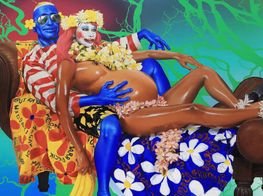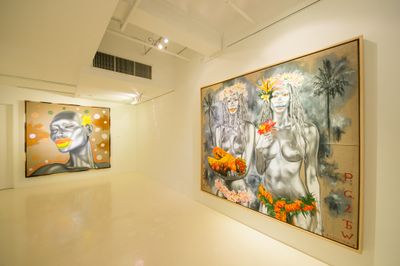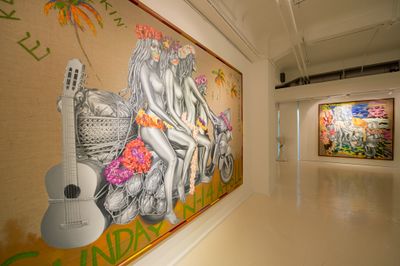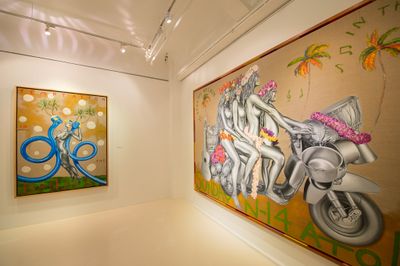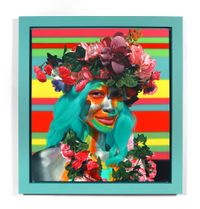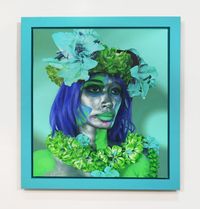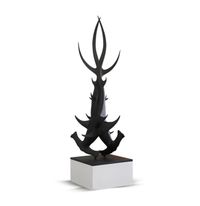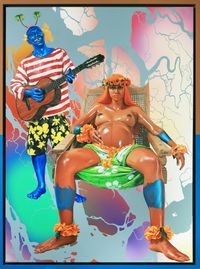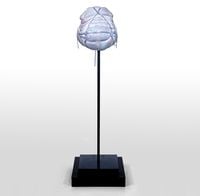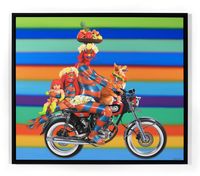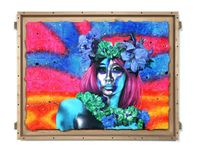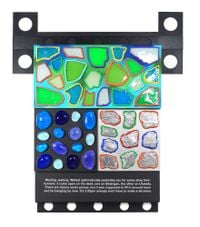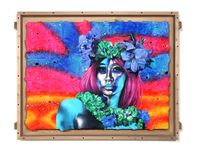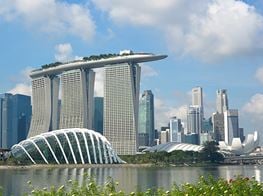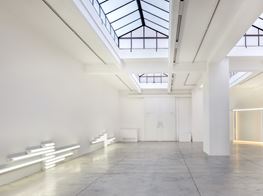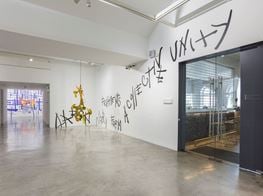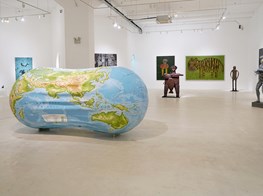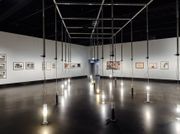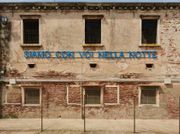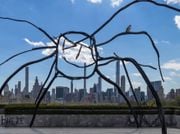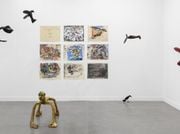Ashley Bickerton
Ashley Bickerton. Courtesy the artist.
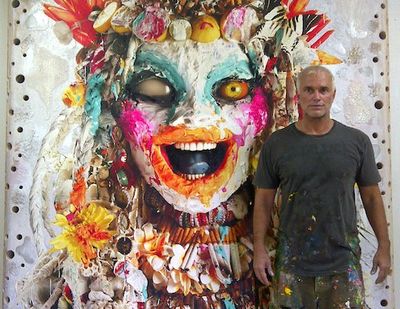
Ashley Bickerton. Courtesy the artist.
In conversation with Ashley Bickerton he references David Ostrowski as a painter he follows. The reference is unexpected. A type of erasure and emptiness has defined Ostrowski's recent practice, whereas Bickerton's work has often been elaborate in its presentation: from his industrially fabricated 'wall contemplation units' decorated with corporate logos that brought him to prominence as a neo-conceptualist in New York during the late 1980s, to his high resolution digital photographs overlaid with found objects and heavy impasto.
A 2013 solo show at Lehmann Maupin featured medusa-like Madonnas heavily painted in a cacophony of colours with coiled dreadlocked hair, bulging eyes, exploding lips, and cigarette necklaces. More recently he has been painting canvas with perfectly rendered vignettes depicting a type of tropical apocalypse.
When I meet with Bickerton in Singapore, during Art Stage, we sit before a large double portrait of Bickerton's wife. Bare breasted, painted silver and with the smeared overblown lips that have come to also characterise the protagonists in his most recent work, she appears with a floral wreath on her head and around her waist. Behind the two figures, a silver scene of island paradise is depicted, but much of the canvas is also left raw—an unconscious nod to Ostrowski perhaps? Bickerton explains that the work references both Gauguin's Two Tahitian Women and also Andy Warhol's Silver Double Elvis. He is simultaneously paying homage, and 'riffing' on the two masters. But he's worried he has gone too far.
While Bickerton acknowledges that the layman might not recognise the Gauguin or Warhol references, he is somewhat concerned that people might not get his work at all—that they might associate it with the truly kitsch work he parodies. He is concerned they might not understand it within the context of its conceptual roots.
An early work like Tormented Self-Portrait (Susie at Arles) (1987–1988), which sits within MoMA's collection is considered a seminal work of 'Neo Conceptualism' and he says it is ultimately about painting, and particularly about portraiture. The work is pivotal in the story of Bickerton's rapid ascent to fame in the late 1980s, when he along with Jeff Koons, Peter Halley and Mayer Vaisman were included in a four-person show at Sonnaband Gallery in 1988. The term 'Neo-Geo' developed on the back of this exhibition, and the careers of the 'fantastic four' (as they came to be referred to in art circles) were subsequently launched into the stratosphere.
Bickerton explains that while Tormented Self-Portrait is about parodying the minimalism of Donald Judd—part of a repertoire of satires he could deliver on the dubious subject of 'art about Art'—it is also part of the Logo Series, which came out of wanting to explore portraiture. He explains that the series was developed following a walk around a giant Van Gogh retrospective: 'I got that idea from seeing Van Gogh's exhibition at the Met. And walking around and around and looking at painting after painting of the cavernous angst of Vincent's eyes; and suddenly realising that I couldn't do it—but I could do it. I could do it in another way.' Tormented Self-Portrait draws from a personal selection of logos from a finite catalogue of branded choices to represent the individual—to propose an alternative form of self-portrait.
This year marks the 25th anniversary since Tormented Self-Portrait was painted and this line in the sand has provided Bickerton with the space to reflect back on a long and ultimately successful career. Despite its disparate parts and dramatic transformations—from the coolly abstract sculptures of the Logo Series, to the eco-riff assemblages in the Travelogue Series, to the more recent highly rendered paintings included in Junk Anthropologies, his current Gajah Gallery exhibition in Singapore—Bickerton's work has ultimately always been firmly grounded in a conceptual practice. He has spent his career developing his own unique and rich vocabulary, using the world and its signs as a rich repertoire of ready-made images to challenge, excavate, critique, parody, and venerate the formal possibilities and definitions of the traditional art forms. And it is for this reason the reference to Ostrowski, an artist ultimately concerned with examining painting by undermining its very form and composition, is in fact not at all surprising.
An extract of Anna Dickie's conversation with Ashley Bickerton is provided below.
ADI read you are going to re-visit Tormented Self-Portrait (Susie at Arles)?
ABI have got into arguments about this—even with my own gallery. They think I might be exploiting it. I divorced myself from a lot of my early work. I ran away from it. I didn't want anything to do with it. I hated it. I dumped it. And little by little I realised that it never really left. All of the plays are still there. More and more recently I have realised that at the root of everything—that work, and this work here, is parody. The work is still always about the question of what is an artwork. What is an art object? It is still about turning painting inside out.
I hated the way my old work imprisoned me and that is why I struggled so hard to break out.
ADDo you mean imprison in terms of the label, Neo Geo? In terms of your grouping with the 'fantastic four'?
ABYes, in both the literal and figurative sense. I was boxed by the box. And that was hard. And then also, years where every intro written about me started 'Ashley Bickerton, who came up in the East Village as part of Neo Geo with Jeff Koons, Peter Halley'. It was the thorn in my side.
ADYou spent many years escaping that label—but how do you now want to be defined?
ABI feel I strayed too far from my conceptual roots. My work has been grounded in that history. I got to the point where ... actually take for example Artsy! They put my work with 'kitsch'!
ADBut your work does use kitsch, and I suppose your involvement with that definition gets generated from Artsy's complex genome system?
ABYes, but God, I have seen kitsch and I have suddenly realised that wasn't what I wanted it to be. I wanted to re-establish my conceptual roots. When I was doing paintings of overgrown gruesome, bombastic figures and then the images and the frames turned gold. If you just saw them in isolation, you wouldn't know I was the artist I was. And so with the twenty-fifth anniversary of the Logo piece, I wanted to navigate and investigate the two languages. I have been in this game for a long time now, and I have come full circle. I want to put it all together. Now there is enough track and territory laid down, I can step back and see the overarching language, not the disparate parts.
ADSo revisiting Tormented Self-Portrait—it's about reflecting on what you have always been saying?
ABYes. So for all the naysayers who say don't do it, well tough. I have good reason to do it. —[O]

